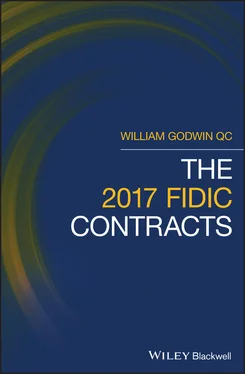3.2.3 Instructions: The 2017 Provisions
Instructions are dealt with in largely the same way in the 2017 editions of all three Books, albeit with different numbering: clause 3.5 in the Red and Yellow Books, clause 3.4 in the Silver Book.
Clause 3.5/3.4 provides that the Engineer or Employer, through the Employer's Representative, may issue at any time instructions to the Contractor necessary for the execution of the works in accordance with the Contract.
It is expressly provided that the Contractor may only take instructions from:
1 (a) the Engineer/Employer's Representative; or
2 (b) the Engineer's Representative (Red or Yellow Book), if appointed; or
3 (c) an assistant with the appropriate delegated authority.
This establishes a clear channel of communication. Clause 3.5/3.4 then provides that, subject to a proviso concerning variations, the Contractor must comply with any instructions given on any matter related to the Contract.
The proviso is that if an instruction states that it constitutes a variation then clause 13.3.1, relating specifically to variation instructions, is to apply. This clause is considered in Section 11.3.1 below.
3.2.4 Where the Instruction Does Not State that it is a Variation
If the instruction is not stated to be a variation, but the Contractor considers either:
1 (a) that it does constitute a variation (or involves work that is already part of an existing variation); or
2 (b) that the instruction does not comply with applicable laws or will reduce the safety of the works or is technically impossible
then he is immediately, and before commencing any work related to the instruction, to give a notice to the Engineer or (if Silver Book) the Employer with reasons. The Engineer/Employer is to respond within seven days after receiving this notice, by giving a notice confirming, reversing or varying the instruction. If he does not do so within this time he will be deemed to have revoked the instruction. Otherwise, the Contractor is to comply with and be bound by the terms of the Engineer's or Employer's response.
3.2.5 Clause 3.5/3.4 Sub‐paragraph (a)
The provision referred to in sub‐paragraph (a) of Section 3.2.4, above, is intended to avoid a situation which often arises under the 1999 contracts. The Engineer/Employer might issue an instruction without identifying whether it amounts to a variation. If the Contractor believes that it does constitute a variation, he will raise the matter with the Engineer or Employer and, if the Engineer or Employer does not agree, or does not address the matter, pursue it as a claim while continuing with the work. This leaves the matter in limbo and can in some cases mean that it is not resolved until some time later, even if the initial 28‐day claim notice under clause 20.1 is issued to preserve the Contractor's position.
It was thought that the project might be better managed by requiring the Engineer or Employer to identify whether an instruction constituted a variation and seeking at least to some extent to have the question whether it actually was a variation dealt with as it arose.
The 2017 contracts therefore require the Contractor to raise ‘immediately’ the issue whether an instruction does constitute a variation, giving reasons why he contends that it does, and in the meantime to hold back from commencing any work related to the instruction. To avoid undue delay to the works the Engineer/Employer must respond within seven days to the Contractor's notice; and in his response he must either confirm, reverse or vary the instruction. The deeming provision designed to give force to this time limit is that, if he fails to respond within the seven days, he is deemed to have revoked the instruction. If, however, he does respond within time the Contractor must comply with the terms of the response and so, if the instruction is confirmed, must proceed with the works accordingly.
This clause thus gives the Contractor the opportunity to raise as soon as the instruction is given the issue whether it constitutes a variation together with providing his reasons for that position; the expression ‘immediately’ is undefined, and it may well be the case that the Contractor will require some time after the instruction is issued before he can appreciate if it does amount to a variation, and articulate his reasons for taking that view. A response after such a period might well be ‘immediate’ and it was not therefore felt appropriate to define when the Contractor might raise the point more precisely, still less to attach any express time bar to it; but it is acknowledged that whether the Contractor has raised the matter quickly enough might give rise to argument.
The Engineer's/Employer's response may well not resolve the question whether the instruction constitutes a variation since within the seven days he might simply confirm the instruction and need not give any reasons in response to the Contractor's reasons why he (the Contractor) considers that the instruction was a variation. It does, however, at least give the Contractor the opportunity to raise the matter in a considered way as it arises, and the Engineer or Employer an occasion to consider or reconsider if what he has instructed is a variation; the Engineer/Employer may be as eager to avoid unnecessary disputes as the Contractor. If the Contractor believes the response fails to address his points and that the instruction constitutes a variation he may, subject to clause 20.2, 5 claim an extension of time and/or additional payment for any delay or additional cost resulting to him from complying with the instruction as if the instruction were treated as a variation under clause 13.3.1.
3.2.6 Clause 3.5/3.4 Sub‐paragraph (b)
If an instruction is not stated to be a variation, and the Contractor does not consider that it is, but does believe that the instruction fails to comply with applicable laws or will reduce the safety of the works or is technically impossible, then under sub‐paragraph (b) of clause 3.5/3.4 he must, again before commencing any work related to the instruction, immediately give a notice to the Engineer/Employer with reasons for his view. The same seven‐day response is required from the Engineer/Employer confirming, reversing or varying the instruction, with the Contractor being bound to comply with the terms of the Engineer's /Employer's response, provided the notice is given in time.
The purpose of this provision is to deal with instructions which are not stated or considered by the Contractor to be variations but where the Contractor considers that the instruction fails to comply with applicable laws, will reduce the safety of the works or is technically impossible. The 2017 Books thus introduce a specific right to object to an instruction in three specific situations where there would otherwise not be (and was not in the 1999 editions) any right to object. The Engineer/Employer has the final word, however, and may confirm the instruction despite the Contractor's objection. 6
3.3 Agreement or Determination
The procedure for obtaining the parties' agreement or issuing a determination if no agreement is forthcoming has become far more detailed and structured than in the 1999 editions of the contracts, with greater emphasis on consultation involving the parties and the Engineer/Employer's Representative. The procedure is the same in all the 2017 contracts, although, as noted above, it is set out in clause 3.7 of the 2017 Red and Yellow Books and clause 3.5 of the Silver Book. As also noted above, the process of agreement or determination covers not merely claims but applies whenever the conditions of contract require the Engineer or Employer's Representative to proceed to determine any matter or claim.
Читать дальше












